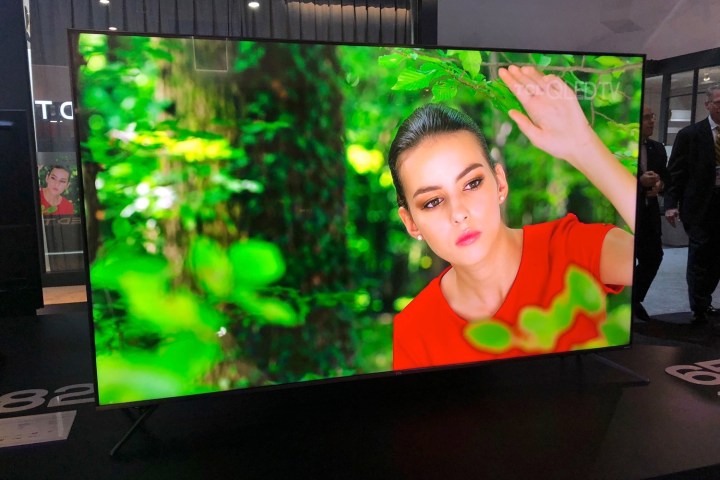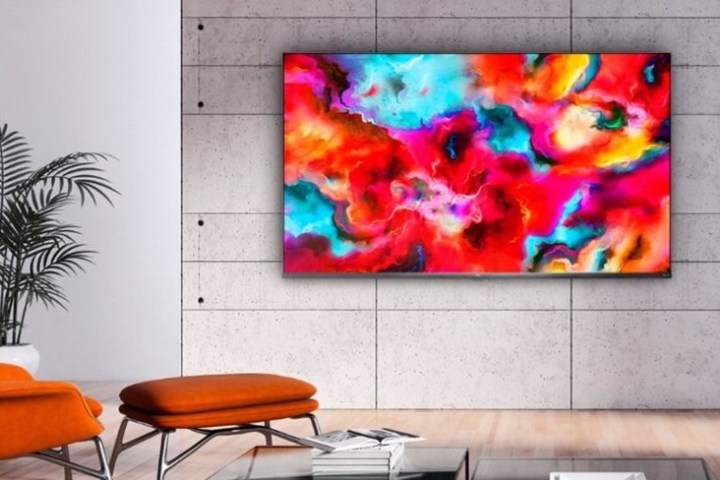Choosing a new TV means encountering an onslaught of the latest technology terms — and one term you may have seen more frequently these days is QLED. This upgrade from traditional LED designs could be a potential replacement for your old TV, but we think you should know the details first. Here’s the rundown.
What is QLED?
QLED is a proprietary display panel technology short for “quantum dot LED.” Quantum dot technology was originally announced by Sony via a partnership with QD Vision, but Samsung rapidly brought its own version to market and currently owns the QLED trademark, working with a variety of specialized manufacturers to put the panels together. The first consumer QLED displays began showing up several years ago. Now the technology is relatively common and affordable — if you take a look at the best TVs available today, most of them are probably QLED.

What does QLED actually do? It solves a problem that traditional LED TVs have wrestled with for years. In order for a TV’s color filter to produce the most vivid and accurate colors, it needs to start with a very pure, full-spectrum source of white light. But how do you improve color accuracy when even the best white LED backlights produce light that isn’t perfectly white?
QLED solves this problem by adding a layer of quantum dots to a TV’s LED backlight (thus the Q in QLED). These quantum dots are tiny phosphorescent crystals that possess an almost magical quality: When they’re exposed to light, they emit their own light with a very high level of efficiency. The light they emit can be tuned to specific portions of the color spectrum.
So QLED TVs swap out white LEDs for blue LEDs and then layer red- and green-tuned quantum dots on top. The quantum dots absorb the blue light from the LEDs and convert it into red and green light. When the blue light from the LEDs combines with the red and green light emitted from the quantum dots, you get a very pure, full-spectrum white light. This gives the color filter the starting point it needs, and because of the efficiency of quantum dots, almost no brightness is lost in the process.
This gives an LED TV the ability to display more colors with greater accuracy and (if the LED backlight is sufficiently powerful) incredible brightness. This benefits standard dynamic range (SDR) material, but it’s especially helpful when displaying high-dynamic range (HDR) video, which relies on high brightness and contrast.
So it’s only available on Samsung TVs?
No. Samsung helped to popularize quantum dot technology, and it established the QLED trademark, but most TV makers have quantum dot-based TV models these days. Samsung established the QLED Alliance in partnership with Hisense and TCL for the purpose of promoting the QLED term to TV buyers, but so far, these three companies remain the only ones that use it in their marketing.
Other companies use their own terminology. Vizio adds the word quantum to models that use quantum dots, e.g. Vizio P-Series Quantum, while both Sony and LG have a tendency to avoid the term entirely despite using quantum dots in some of their LED TVs.

Is QLED better than OLED?
They are very different display technologies, so comparisons between the two are a little tricky. For a deeper dive, we suggest taking a look at our article on QLED versus OLED.
For a quick rundown, here’s how it works: OLED stands for organic light-emitting diode. This type of display panel completely replaces older LED designs with a thin panel of pixels that can produce their own light and target colors as needed without relying on the backlighting that LED panels use.
OLED panels are slim and offer incredibly vivid colors, exceptional contrast levels with the deepest blacks around, and no light-bleeding issues. If you are primarily interested in contrast, it’s probably your best pick for a TV. However, OLED also has downsides compared to QLED. While prices have fallen, it’s still an expensive technology compared to the alternatives. OLED can also struggle with image retention/burn-in depending on how the TV is used and has innate limitations when it comes to brightness levels.
Does QLED work with 4K?
QLED advances how LED backlighting and color filtering work, while 4K (UHD) is determined by the number of pixels on the panel. As such, QLED technology can be used on 4K, 8K, or any other resolution that comes along.
How expensive are QLED TVs?
QLED TVs come in a broad range of prices. They are currently more expensive than traditional LED TVs and a bit more affordable than OLED TVs. If you take a look at our list of the best QLED models, you’ll see they can range from around $5,000 for a high-end 8K version to around $1,300 for a budget 4K model.

Is QLED good for gaming?
Because QLED enhances colors and brightness, it can make all genres of games more enjoyable, even if you settle for a lower resolution. You may want to play around with settings and different modes, however — not everyone thinks that game modes are inherently better on QLED TVs.
If you’re thinking about QLED versus OLED for a gaming TV, that’s a harder question. OLED is a superb choice since it offers excellent color and contrast — ideal for enjoying in-game environments — and super refresh rates, which is great for fast-action titles. However, gaming TVs are more at risk of being left on the same screen for extended periods of time, which can exacerbate OLED’s own risk of burn-in. QLED doesn’t have the same problem.
What’s Neo QLED?
This is a newer, more advanced form of QLED that Samsung is offering. It replaces the traditional LED array with a mini-LED backlighting system. We discuss mini-LED in more depth here, but essentially, it’s a panel of extra-small LEDs that can offer incredibly accurate lighting zones for improved image quality.
Editors' Recommendations
- What is Dolby Vision? The dynamic HDR format fully explained
- The best TV brands of 2023: from LG to TCL, which should you buy?
- TV brightness wars: how bright does your TV need to be?
- Samsung’s 2023 Neo QLED TVs start at $1,200 — and you can buy them this week
- Every TV type, explained






